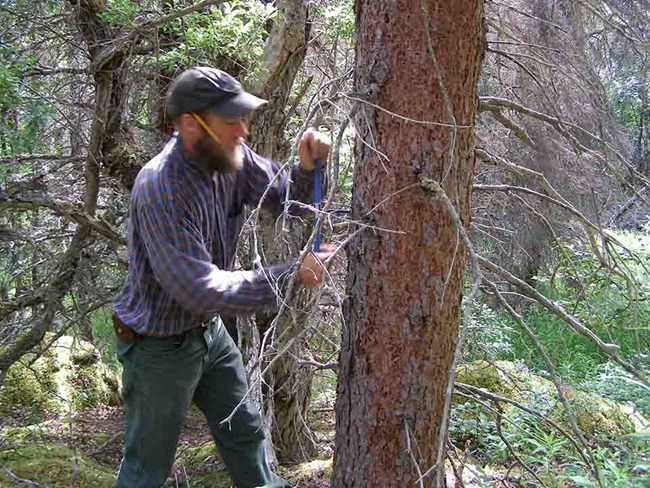Last updated: December 30, 2019
Article
Tree Rings Reveal Drought Stress

Tree‐ring isotopes reveal drought sensitivity in trees killed by spruce beetle outbreaks in south‐central Alaska
North American forests are experiencing reduced growth and increased tree mortality, particularly due to increased temperatures. A recent study examining white spruce trees affected by an outbreak of the spruce beetle in southcentral Alaska highlights the effects of increasing temperatures on northern forests. Researchers found that trees killed by the beetle outbreak were more sensitive to both warmer temperatures and reduced water availability than the trees that survived. By examining the carbon and oxygen isotopes in tree rings, scientists were able to determine if the trees were exposed to drought stress.
This study underscores an important point: increasingly warmer and drier climate conditions can test trees' resiliency. As exemplified in this study, trees that are exposed to warmer and drier conditions are more susceptible to spruce beetle outbreaks. The findings of this study are important for all North American forests as they experience higher temperatures and drier climates, leading to decreased resiliency. Studies like this one allow scientists to forecast vulnerable areas and possible mortality events.
Abstract
Increasing temperatures have resulted in reduced growth and increased tree mortality across large areas of western North American forests. We use tree‐ring isotope chronologies (δ13C and δ18O) from live and dead trees from four locations in south‐central Alaska, USA, to test whether white spruce trees killed by recent spruce beetle (Dendroctonus rufipennis Kirby) outbreaks showed evidence of drought stress prior to death. Trees that were killed were more sensitive to spring/summer temperature and/or precipitation than trees that survived. At two of our sites, we found greater correlations between the δ13C and δ18O chronologies and spring/summer temperatures in dead trees than in live trees, suggesting that trees that are more sensitive to temperature‐induced drought stress are more likely to be killed. At one site, the difference between δ13C in live and dead trees was related to winter/spring precipitation, with dead trees showing stronger correlations between δ13C and precipitation, again suggesting increased water stress in dead trees. At all sites where δ18O was measured, δ18O chronologies showed the greatest difference in climate response between live and dead groups, with δ18O in live trees correlating more strongly with late winter precipitation than dead trees. Our results indicate that sites where trees are already sensitive to warm or dry early growing‐season conditions experienced the most beetle‐kill, which has important implications for forecasting future mortality events in Alaska.
Csank, A. Z., A. E. Miller, R. L. Sherriff, E. E. Berg, and J. M. Welker. 2016. Tree-ring isotopes reveal drought sensitivity in trees killed by spruce beetle outbreaks in southcentral Alaska. Ecological Applications 26:2001-2020.
